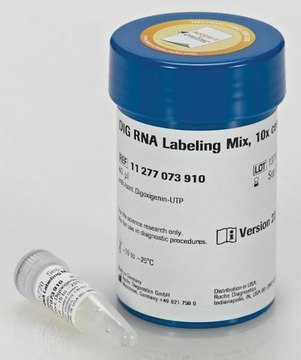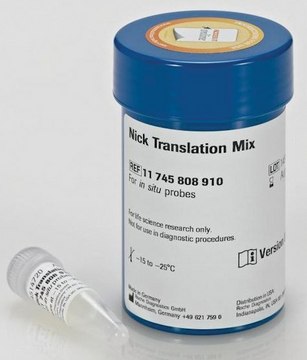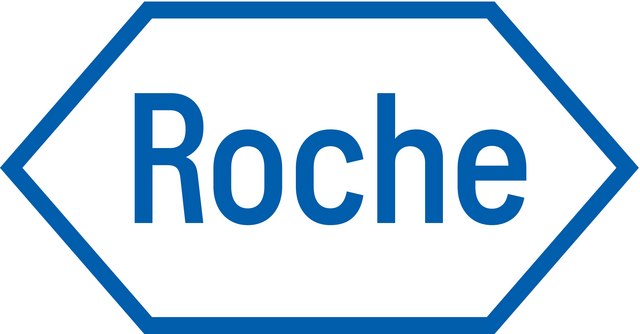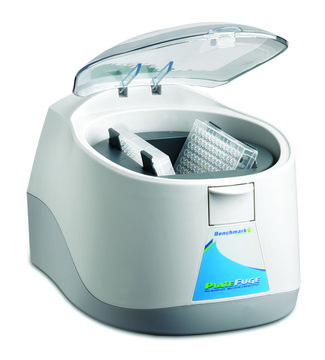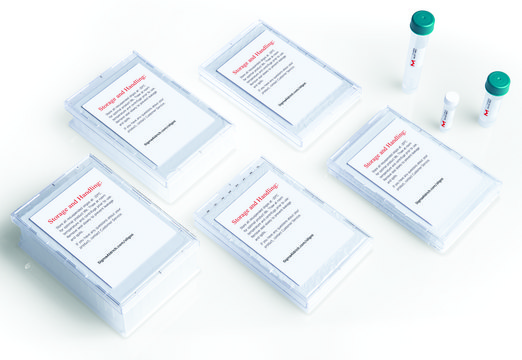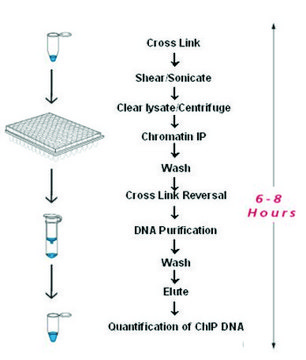11745824910
Roche
Biotin-Nick Translation Mix
suitable for hybridization, solution, sufficient for 40 labeling reactions, pkg of 160 μL
Synonym(s):
nick translation
Sign Into View Organizational & Contract Pricing
All Photos(1)
About This Item
UNSPSC Code:
41105500
Recommended Products
form
solution
Quality Level
usage
sufficient for 40 labeling reactions
packaging
pkg of 160 μL
manufacturer/tradename
Roche
technique(s)
hybridization: suitable
storage temp.
−20°C
General description
Convenient enzyme and nucleotide mixture.
Nick translation utilizes a combination of DNase and DNA Polymerase to nick one strand of the DNA helix, then incorporates labeled nucleotides as the polymerase examines, or "proofreads" the nicked site. The molar ratio of Biotin-16-dUTP to dTTP is adjusted to ensure that every 20th to 25th nucleotide in the newly synthesized DNA is modified with biotin. This density of haptens in the DNA yields the highest sensitivity in the immunological detection reaction.
Large plasmids, cosmids, and PCR fragments are all regularly used with this method, and the DNA can be linearized or supercoiled. Individual templates produce consistent results in the standard 90-minutes reaction, and result in an average probe length of 200 base pairs up to 500 base pairs.
Nick translation utilizes a combination of DNase and DNA Polymerase to nick one strand of the DNA helix, then incorporates labeled nucleotides as the polymerase examines, or "proofreads" the nicked site. The molar ratio of Biotin-16-dUTP to dTTP is adjusted to ensure that every 20th to 25th nucleotide in the newly synthesized DNA is modified with biotin. This density of haptens in the DNA yields the highest sensitivity in the immunological detection reaction.
Large plasmids, cosmids, and PCR fragments are all regularly used with this method, and the DNA can be linearized or supercoiled. Individual templates produce consistent results in the standard 90-minutes reaction, and result in an average probe length of 200 base pairs up to 500 base pairs.
Specificity
Heat inactivation: Stop the reaction by adding 1 μl 0.5 M EDTA (pH 8.0) and heating to 65 °C for 10 minutes.
Application
For generation of highly sensitive probes for in situ hybridization labeled with Biotin-16-dUTP.
Note: The mix can also be used for filter hybridization techniques, however, for highly sensitive filter hybridization probes, we recommend that you use Biotin-High Prime from Roche Applied Science.
For nonradioactive labeling of in situ probes with other haptens, Roche Applied Science offers the DIG-Nick Translation Mix or the Nick Translation Mix.
Note: The mix can also be used for filter hybridization techniques, however, for highly sensitive filter hybridization probes, we recommend that you use Biotin-High Prime from Roche Applied Science.
For nonradioactive labeling of in situ probes with other haptens, Roche Applied Science offers the DIG-Nick Translation Mix or the Nick Translation Mix.
Quality
Function tested in a dot blot assay.
Principle
The nick translation method is based on the ability of DNase I to introduce randomly distributed nicks into DNA at low enzyme concentrations in the presence of MgCl2. E. coli DNA Polymerase I synthesizes DNA complementary to the intact strand in a 5′ → 3′direction using the 3′-OH termini of the nick as a primer. The 5′ → 3′ exonucleolytic activity of DNA polymerase I simultaneously removes nucleotides in the direction of synthesis. The polymerase activity sequentially replaces the removed nucleotides with isotope-labeled or hapten-labeled deoxyribonucleoside triphosphates. At low temperature (+15°C), the unlabeled DNA in the reaction is thus replaced by newly synthesized labeled DNA.
Physical form
1 vial with 5x concentrated stabilized reaction buffer in 50% glycerol (v/v) and DNA Polymerase I, DNase I, 0.25mM dATP, 0.25mM dCTP, 0.25mM dGTP, 0.17mM dTTP and 0.08mM Biotin-16-dUTP.
Preparation Note
Assay Time: 100 minutes
Sample Materials
Supercoiled and linearized plasmid DNA
Supercoiled and linearized cosmid DNA
Purified PCR products
Note: Denaturing of the template before nick translation is not required.
Sample Materials
Supercoiled and linearized plasmid DNA
Supercoiled and linearized cosmid DNA
Purified PCR products
Note: Denaturing of the template before nick translation is not required.
Other Notes
For life science research only. Not for use in diagnostic procedures.
Storage Class Code
12 - Non Combustible Liquids
WGK
WGK 1
Flash Point(F)
No data available
Flash Point(C)
No data available
Choose from one of the most recent versions:
Already Own This Product?
Find documentation for the products that you have recently purchased in the Document Library.
Customers Also Viewed
Our team of scientists has experience in all areas of research including Life Science, Material Science, Chemical Synthesis, Chromatography, Analytical and many others.
Contact Technical Service
